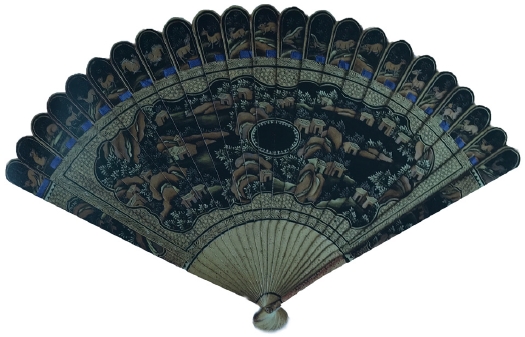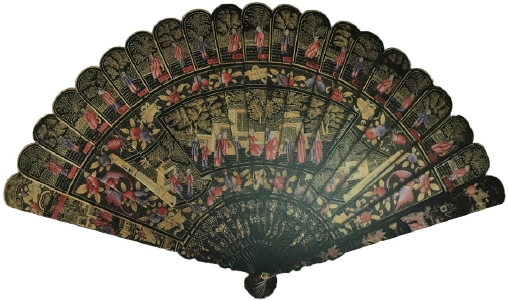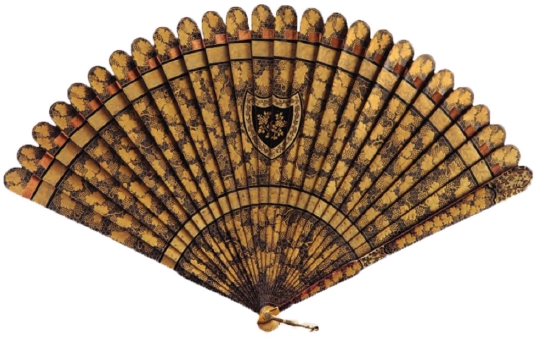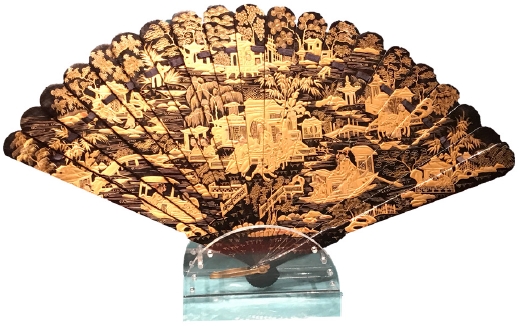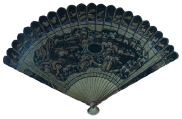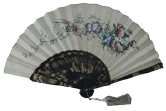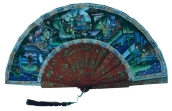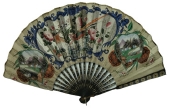
An Analysis of the Lacquer Art of the Exported Folding Fans of the Qing Dynasty in China
Abstract
Background The lacquered folding fans of the Qing dynasty in China produced for export from the 18th to the 20th centuries, were crafted in Guangzhou and other places in China for sale to foreigners. They catered to the trend of Chinoiserie, reflecting the state of East-West communication while also representing the traditional lacquer art of Guangdong.
Methods Based on the types of fans collected by the Guangdong Museum and the Guangdong Folk Crafts Museum, this study used the methods of literature analysis, lacquer technology, typology, and space aesthetics.
Results The export folding fans have been popular with European and American consumers from the 18th to the 20th centuries. The materials, tools, and decorative techniques of lacquer folding fans are special, which encapsulates the wisdom of Chinese aesthetic philosophy. Lacquered patterns on the folding fans have themes of plants, animals, landscapes, courtyards, mandarin figures, literati, and geometric forms such as shield-shaped flares and badge patterns. There are two kinds of structural forms of lacquered folding fans: full-body painting and partial painting. The spatial aesthetics of the lacquer-painted pictures on folding fans display from three perspectives: one-sided, double-sided and multi-sided. They have different aesthetic presentations.
Conclusions Lacquer decorative techniques and the structural forms are special. The lacquer exported folding fans combined the tastes and mirrored the visions of China and the West at that time, and thus, they have unique aesthetic characteristics and significance. Under the background of increasing industrialization and digitalization, export folding fans embody traditional art to empower contemporary design in the aspects of decorative patterns, technology development, aesthetic culture and craftsman spirit, which has a positive impact on the future design.
Keywords:
Lacquer Art, Engraved Gold, Pattern Contents, Structural Forms, Spatial Aesthetics1. Introduction
Concurrent with the prosperous period of the Qing Dynasty in China, Rococo Art rapidly gained popularity in Europe. The French painter Boucher depicted many court ladies in Qing Dynasty costumes holding Chinese folding fans. European countries were full of enthusiasm for fans. Queen Elizabeth I of England had 27 fans in her collection. Chinese fans were spread to the West through trade, such as that of the East India Company. Before the 16th century, only flag fans, feather fans and other non-foldable flat fans existed in Europe. The Chinese folding fans decorated with lacquer in the Qing Dynasty were light, bright, ornate, moisture-proof and insect-proof. They came to be known in China as the best-selling Western style. Guangzhou had been a port for foreign trade since the Han Dynasty. In the 24th year of Kangxi (1685), Guangdong Customs was established in Guangzhou, and the trade on the Maritime Silk Road flourished. In the 22nd year of Ganlong (1757), the government closed the three customs offices of Fujian, Zhejiang and Jiangsu, leaving only Guangzhou as the port for foreign trade. Thus, exported folding fans crossed the sea from Guangzhou to Europe and the United States. The Qing Dynasty lacquered folding fans have rich features and great research value because of their integration of Eastern and Western characteristics.
1. 1. Literature Review:Records of Lacquer Craft and Fans in Ancient Chinese Classics
There are records of lacquer and silk paid as tribute in the Xia dynasty in the Records of the Grand Historian in the Twenty-Four Histories of China. This text demarcates lacquer materials extracted from lacquer trees as relatively expensive, with a long history in China (Si Maqian, han dynasty). The Book of Han tells of bright, smooth lacquer being used to coat walls, preventing enemies from climbing them, demonstrating lacquer’s importance for resisting offensives (Bangu, han dynasty). The etymology of ‘rujiaosiqi’ (deeply attached) shows that after the lacquer dries, it adheres strongly as firmly and inseparably as glue. The etymology of ‘qiheiyituan' (pitch-dark) indicates that the combination of lacquer and black pigment provides a darker appearance and has strong colour stability. The History of Ming records many instances of lacquer-painted furniture and other implements (Zhang Tingyu, ming dynasty).
The Records of Lingnan Scenery (Wuqi, 1868) and the Strange Tales of Lingnan(Wuqiong, 1991) provide historical records of the ancient Lingnan region, including the Guangzhou traditions of planting lacquer trees and decorating fans, furniture, wood carvings and clogs with lacquer and gold and silver materials. The Book of Jin, one of the Twenty-Four Histories of China, records that the making of Cantonese fans began during the Jin Dynasty(Fang Xuanling elt, 420). Wen Zhenheng of the Ming Dynasty is recorded as having displayed an elegant carved lacquer-handled Chinese scroll fan in his book Zhang Wu Zhi (1591). The fan, a combination of practicality and aesthetics, is the carrier of many cultures, as seen in its symbolism and its literati motifs. After being painted with lacquer, fans became insect-proof, moisture-proof, dust-proof, smooth, delicate and new-looking, complementing their decoration.
1. 2. Literature Review:Research on the Black Paint and Gold Tracing Technique
Huang Cheng's Xiu Shi Lu (2004), the only extant monograph on lacquer work in China, contains a detailed description of the technique of gold tracing, recording the ancient materials of this technique, the steps for using it, and the unique aesthetic and cultural connotations of gold materials. Cultural relic expert Wang Shixiang’s book Explanation of Xiu Shi Lu (2013), lacquer art scholar Chang Bei’s book Explanation of Xiu Shi Lu (2017) and The Illustration of Xiu Shi Lu (2007) provide detailed records of the process, restoration and modern inheritance of the black paint and gold tracing lacquer technique. The artist Shen Fuwen introduced the technique of black lacquer painting to south China, affirming its value and significance, and analysed its development and application in modern times (1991). Yang Boda’s book A Glimpse of the Characteristics and Status of Guangdong’s Crafts from the Old Collection of Qing Dynasty Palace and Guangdong Tributes is another important source for understanding the craft and value of Guangdong black lacquer painting (2003).
1. 3. Literature Review:Studies on Export Propagation of Folding Fans in the Qing Dynasty
There are some descriptions and records of the fans made for export in the Qing Dynasty in the books Fans of Imperial China and The Decorative Arts of the China Trade. Carl L. Crossman recorded the Guangdong fan auction held in New York in 1832 in China Trade: Exporting Paintings, Furniture, Silver and Other Products (1972). The Guangdong Local Chronicles and the 13-line Data Series gave an important introduction to the historical background of ‘China fever’ in Europe and the lacquered folding fans exported from Guangzhou's foreign trade ports(Hu Qiaoli, 2014). Western Style: A Study of Design Culture Centered on Guangzhou in the 18th Century also gives a classified introduction introduction to the export of mass-produced lacquerware in the Qing Dynasty (Gefang, 2017).
1. 4. Literature Review: Records of Painted Folding Fans Exported in the Qing Dynasty
There are many pictures and descriptions of lacquered folding fans made for export in the Qing Dynasty in ‘The Wind Comes from Guangzhou’ (Baifang, 2015), ‘Guangdong-made bone fans for export in Qing Dynasty’ and ‘Chinese Fans’ (Guan Shanming, 2011). Between the collection data from the Guangdong Provincial Museum and the Guangdong Folk Art Museum and the exhibitions of folding fans held over the years, there have been many case analyses and political, economic and cultural background evaluations of exported lacquered folding fans in the Qing Dynasty.
1. 5. Literature Review:Research on Decorative Arts and the Spatial Aesthetics of Chinese Crafts
Michel Pastoureau’s Heraldry: A Culture of Symbols analyses and studies the connotations and forms of patterns and also delineates the relationship between regional culture, national culture and decorative patterns (2002). The History of Chinese Patterns by Tian Zibing (2003), preeminent scholar of the history and theory of Chinese arts and crafts, includes a detailed analysis of the emergence and development of various patterns, the representative patterns of various times and folk customs. Some decorative patterns also have unique manifestations in rich, expressive lacquer art. Space in Art History is a series of lectures by American scholar Wu Hung, in which he identifies space as the key to connecting image and form (2018). This insight provides a new aesthetic perspective not only on painting but also on the spatial structure of implements. It provides methodological guidance for some of the research in this paper.
2. Methods
By 2015, Guangdong Folk Crafts Museum had collected 48 pieces of folding fans made for export to Europe and the United States in the Qing Dynasty. Five of these fans were decorated with lacquer. They were probably made from the early 18th century to the middle or late 19th century. Fourteen lacquer folding fans are recorded in The Wind Comes from Guangzhou, compiled by Guangdong Folk Crafts Museum, and 16 lacquer folding fans were displayed in the Guangdong Museum’s 2018 exhibition ”Fashion: Chinese export fans in the 18th-20th century, a collaboration with the Guangdong Folk Crafts Museum, the Victoria and Albert Museum, the Greenwich Fan Museum and the Fitzwilliam Museum”. Some were made in Macau, some in Guangzhou and some in unknown locations, but all of the fans were made for export from Qing China. After removing works that were deemed too similar, 26 pieces were selected as samples for this study.
The research objectives were based on the above samples and divided into five parts: the first part studies the background of export folding fan by means of literature collation and analysis;the second part studies the lacquer art techniques through the method of art technology, particularly by studied the only existing lacquer technology monograph in China, "Xiu Shi Lu" written by Huang Cheng and Yang Ming in Ming Dynasty; the third part and the fourth part classify the pattern contents and decorative structures by typology; in the fifth part, the lacquer-painted images are analyzed and studied by applying the theories of space aesthetics.
3. Result
3. 1. Historical Background of the Lacquer Folding Fans Made for Export in the Qing Dynasty
Guangzhou has been an important port since its prominence on the Maritime Silk Road in the Han Dynasty, and it became the most important export city for folding fans in the Qing Dynasty. In the early Qing Dynasty, a sea ban was imposed until the 24th year of the reign of Emperor Kangxi (1685) to completely eliminate the vestiges of Zheng Chenggong’s rebellion. And then the locus of trade called the Thirteen Factories was formed around the present Guangzhou Cultural Park. By the 22nd year of Ganlong (1757), the Qing government had closed the customs of Fujian and other cities, and Guangzhou became the only legal foreign trade port along the coast of China. Thus, the Thirteen Factories came to monopolise China’s foreign trade. Thanks to Guangzhou’s unique geographical location and trade privileges, the city had a distinct advantage in the export of fans.
The prosperity of the Qing dynasty paralleled a period of great development for European rococo art. French painter Francois Boucher’s works depicted many courtly noblewomen dressed in Qing Dynasty costumes, as well as interior scenes with Chinese-style decorations. Xu Minglong stated ‘In addition to wearing silk and collecting porcelain and lacquerware, they also competed to build Chinese-style palaces and gardens, decorated so-called “Chinese rooms”, watched “Chinese operas” and held “Chinese dances”. Chinese fever, which prevails in the upper classes, is a fashion...’. (1999, p.131) European countries were enthusiastic for these new small fans. Before the 16th century, Europe had only flat fans with non-folding surfaces, such as flag fans and feather fans. The fans from Qing China were various in form, exquisite in workmanship, colourful and attractive.
Chen Na stated ‘In 1699, goods listed in the Macclesfield shipment from Guangdong to the West included 100,000 fans.’ (2015, p.5) At the beginning of the 18th century, Father Bai Jin’s diary, written on the French merchant ship Seagod, recorded the list of Chinese goods that the ship carried to Guangzhou on its second voyage back to China: ‘There were 4 boxes of fans...1 box of porcelain samples, exhibits and lacquer boxes’ (2001, p.10).The folding fans were very popular in America. Crossman recorded in The China Trade that ‘An auction of “Guangdong Fans” held in New York in 1832 showed ‘nearly 3,000 pieces of at least six kinds of fans for export. The cheapest fans shipped to the United States may not exceed 1 penny, but those of high quality, rare materials and excellent labor may exceed 20 US dollars’ (1972,p. 76). Some of the materials used in the Guangdong fans were very expensive, such as ivory and sandalwood; others had excellent workmanship, which naturally increased their value. Neville John Irons stated ‘In the list of China’s exported goods in the sixth year of the reign of the Qing emperor Guangxu (1880), the number of fans of various types reached 6, 287, 989, with a total value of 38,881 taels of silver’ (1982, p.44) .This shows that the Qing Dynasty produced a large number of fans for export, with popularity as well but low prices in Europe. This type of folding fan was not restricted to sale by the companies of the Thirteen Factories. Hu Qiaoli stated ‘According to the regulations of the 45th year of Ganlong, idle businessmen outside the guild can only deal with foreign businessmen in 8 kinds of commodities such as boots, lacquerware, porcelain, ivory carving, embroidery, fans and straw hats’ (2014, p.19).With the great shifts of power in the later Qing Dynasty as well as in the West, the Western preference for the Chinese style declined, and the once-popular phenomenon disappeared.
Against the historical background of Sino-Western trade, Guangdong’s production of lacquer fans for export prospered due to the demand of overseas markets but eventually declined due to changes in those markets. Such fans were produced exclusively for export, rarely sold in China, and never accepted by China’s mainstream aesthetic ideology. Therefore, records of them in the relevant literature are extremely scarce, and the names of the vast majority of fan makers cannot be verified. Fortunately, to meet the needs of the Western market, a small number of famous fan makers left English signatures on the inner covers of the fan boxes according to the habit of Western artists. They recorded their name, business or address of their fan shops, leaving valuable footprints for our research. For example, ‘Hoaching was a prolific fan maker in the mid-19th century. His fan shop was located at no. 10 Jingyuan Street, in the Thirteen Factories district. He was not only an excellent carver of ivory and sandalwood but also a well-known dealer of gold and silver jewellery and a famous lacquer painter. Houqua, who made lacquer fans, and Linhing, who made both ivory and lacquer fans, were also famous in the West’ (2017, p.62) .
3. 2. Lacquer-Decorating Techniques Used in Qing Exported Folding Fans
The technique of using black or red paint and gold tracing was mainly used in the folding fans made for export. The only extant monograph on lacquer art techniques in China is Xiu Shi Lu, written during the Ming Dynasty. Huang Cheng stated in the chapter titled ‘Lacquer Art Decoration’ (2004), ‘Tracing gold is a way of pasting, not painting. It means forming a pattern by gluing gold or silver powder onto a decorative background of black or red lacquer’ (2004).Among the 26 folding fans, 24 had black lacquer background, and only 2 had red background.
Lacquer art scholar Shen Fuwen called this application of lacquer ‘black or red paint and gold tracing technology’, which is delineated in the ‘Painter’s Data’. The steps are outlined in Table 1.
From the steps in this process, it can be seen that red, black and gold are used. This results in perfect contrast, affording the decoration a nobility of style. The lacquer-painting process results in a square-inch work of art fit onto a fan, which showcases the ingenuity and patience of the artist. Moreover, the lacquer coating of the folding ensures that it can be preserved for a long time. Apart from the characteristics of materials, it takes time to polish the lacquer carefully, and this dimension of time is another reason why the resultant fan is especially precious.
Hong Kong collector Guan Shanming emphasised certain points of interest in this process in Chinese Fans, reproduced in Table 2.
From these points, it can be seen that lacquered folding fans made for export used real gold, and the method used incorporated the natural characteristics of lacquer, such as its moisture-proof and insect-proof qualities, to make Chinese fans beautiful and durable.
Many unique techniques and expressions were used in the process of lacquer decoration. One is the technique of line and surface expression. Huang Cheng said that ‘the paint gold technique is a clay painting decoration' (2017, p.62).But Chang Bei notes that it is not comprehensive enough. The ancient methods of tracing gold include pasting gold, painting gold, clay gold and tracing gold with clear hooks, and are not limited to clay gold painting and lacquer. For example, grapes were depicted by pasting gold or even piling gold in the gold tracing process to create a relief texture effect, whereas the grapevine, the leaf and other parts of the image were depicted by tracing gold with clear hooks to create a line tracing effect and a sense of order, thus forming the contrast between the block surface and the line. This highlights the realistic effect of the grapes, vine branches and leaves, which is in accord with the traditional aesthetic of European stereoscopic perspective.
Another feature of lacquer decoration is the expression of yin and yang. The process of gilding animals with large areas recalls the Xiu Shi Lu, Huang Cheng and Yang Ming stated that ‘when tracing gold, a person paints with mud gold, that is, spring brocade patterns...while fine hooks are yang, and the arrangement is yin, or black lacquer paint is yang, and gold tracing line is yin’ (2007, p.107). Discussing the combing and yin-yang techniques, Chang Bei’s annotation of Xiu Shi Lu breaks the process down into many steps. One such component technique is using ‘black lacquer paint over the golden tracing image to form yin and yang, which is called “shu li”’ (2017, p.62). This is reflected in the modelling of animal images. The black lacquer background is exposed in the animal’s trunk, as it follows the contour and fills the shape of the animal to form a textured effect and patterned structure with gold as yang and black as yin.
A third technique is representing nearness and distance. Although Chinese landscapes do not use the shadows of Western scenery, traditional Chinese art has contributed its own developments in depicting proximity to lacquer art. Yang Ming, making note of Huang Cheng's ‘tracing gold’ technique, said, ‘Gold is divided into gold, green gold and red gold’. The paint is mixed with different kinds of gold, which is either filled in or halo dyed’ (2007, p.107).For example, in the decoration and depiction of landscape scenery, the difference between the shade and the sun on the mountains and the perspective of the distant and the near is first delineated using the different tones of gold, green gold and red gold. Then, the artist creates textures and layers with shading and increasing thickness with a halo of gold, which creates the realistic feeling of mountains and waters by means similar to those used in the rendering of traditional Chinese paintings.
3. 3. Lacquered Pattern Types of Qing Exported Folding Fans
From the Table 3, we know that in the 26 samples, plant-pattern decorations appeared 22 times, accounting for 85% of the fans; animal-pattern decorations appeared 4 times, accounting for 15%; landscapes and courtyards appeared 17 times, accounting for 65%; character images appeared 11 times, accounting for 42%; and geometric patterns appeared 8 times, accounting for 30%. It can be seen that the plant patterns are the most common, followed by the landscapes and courtyards. The least frequent motif is the animal pattern.
There are two types of plant patterns: the realistic image, which conforms to the attributes of plant typology, and the decorative planar pattern, which has a sense of order and rhythm of form. The former includes fruits and branches of trees that grow in the south, whereas the latter includes grapevine patterns, brocade-ground-rolled-grass patterns, pomegranate patterns, broken-leaf patterns and flower patterns. Some images on the fans are of both types. The grapevine pattern, which was the most popular type in the Ganlong and Jiaqing period, carries the symbolic meanings of good luck, gentlemanliness and fertility, which are derived from traditional Chinese culture. Taking the grape designs on the black-painted gold folding fans as an example, this pattern has undergone many changes. Some artists depict the fruit in a realistic manner. Other artists attach importance to the abstract representation of the branches, leaves and vines, and the resultant images have the aesthetic feeling of planar decoration. This is a typical theme that not only has the charm of Chinese painting but also conforms to Western aesthetics.
Animal patterns may include rats, deer, lions, sheep, frogs, pigs, wolves or dogs. These images are very small, but the golden lines are delicate, the animal shape is clear, the fur is visible and the posture is dynamic. Some traces of the combination of techniques from China and the West can be seen in the work of the painters of the Qing Dynasty. For example, the ‘black lacquer paint and gold tracing with mountain and water folding fan’ (figure.1) depicts an animal at the top of each fan blade. There are also traditional patterns of auspicious mythical animals in China, such as the phoenixes in the ‘black lacquer paint and gold tracing with opening light landscape village fan’, which uses elegant curves and the pattern to perfectly combine an auspicious symbol with aesthetic meaning.
In the early days of the reign of the Daoguang Emperor, the popularity of the grapevine pattern used in folding fans gradually gave way to pavilions, terraces and landscape gardens. Landscape and courtyard patterns use the perspective and compositional rules of traditional Chinese painting, which is quite different from the stereoscopic expressions, composition habits and painting styles used in Western oil painting. In the decorative space of the ‘black lacquer paint and gold tracing landscape pattern folding fan’, thousands of mountains can be seen from a bird’s-eye view, and one can imagine oneself climbing mountains. Some show panoramic landscapes on the fan surface (figure. 1), and some depict mountains and rivers as seen from a small open window (figure. 2). Each has its own elegant demeanour, and they have opened the eyes of Westerners to the appreciation of Chinese landscapes.
Within the landscape category, one pattern is that of the Chinese courtyard. ‘The peak of European fascination with Chinese gardens came in the second half of the 18th century’. French missionary Attire Jean-Denis (1702-1768) once said, ‘What they [China] want to build is not all palaces that conform to the principle of symmetry and proportion, but villages and countryside that are natural and pristine and far from the world. Therefore, the pavilions I saw in the royal garden are far apart from each other but have nothing in common’ (1979, p.416). The ‘black lacquer paint and gold tracing with colourful garden figure grain folding fan’ (figure.3) depicts a Chinese courtyard, cornices with upturned corners and winding paths into seclusion, and it generally appears quite ‘oriental’. The houses and corridors transition naturally, creating a story-like feeling similar to that in comic books, resulting in a scenic aesthetic.
Images of Chinese figures dressed in the garb of ancient times is a subject with particularly Chinese characteristics in the tradition of lacquer-paint folding fans in the Qing Dynasty. One such image is that of the mandarin, a typical representation of a Qing official. Another is the image of an ordinary member of the literati, wearing a long gown and a hat called a ‘futou,’ which was worn by literati in the Tang and Song Dynasties.
The word ‘mandarin’ first appeared in the early 17th century. When Portugal started to trade with China, the Portuguese used this word to refer to Chinese officials, whether civil servants or military commanders, senior or petty officials. The word comes from the Portuguese verb mandar, which means ‘to rule or manage’. Westerners who went to trade with the East continued to use the term to refer to local officials at all levels in the Qing Dynasty. Qing-costumed characters often appeared on exported folding fans, such as on the ‘black lacquer paint and gold tracing with colourful garden figure grain folding fan’ (figure.3). They stand or sit in courtyards, chatting and communicating. This motif reflects the Western imagination of the elegant tastes of literati in the Qing Dynasty. To accord with European preferences, Chinese artisans depicted Manchu officials on fans to represent Chinese culture, which was not only a trade decision to meet the needs of overseas markets but also an artistic means to depict and spread Chinese historical contexts and civilised customs.
The image of a figure dressed as an ancient member of the literati is elegant in style. The ‘black lacquer paint and gold tracing with irregular folding fan’ depicts three scholars dressed in literati clothing, which was popular in the Tang and Song Dynasties, illustrated in black lacquer and gold tracing. The three figures look at each other as they converse. Behind them are a fence and a bamboo forest, imparting a leisurely and carefree atmosphere. The main body of the ‘black lacquer paint and gold tracing with story folding fan’ contains an image of literati with a circle of ornaments around them, including auspicious objects such as harps, books, paintings, money and fish drums, reflecting the identity and lifestyles of the literati, as well as Westerners’ yearning for their elegance. This imagery would have matched the aesthetic tastes of rococo with its colourful, complicated and magnificent patterns. It opens a window through which Westerners might understand and observe China.
Geometric patterns have nothing to do with perceptions of East or West. Many regular and irregular geometric patterns can be seen on lacquered fans for export, such as on the ‘black lacquer paint and gold tracing lacquer folding fan’ with its brocaded hexagonal patterns. The ‘black lacquer paint and gold tracing grape grain folding fan’ provides another example, with its grid-like honeycomb patterns on the side of the grape grain and along the fan gear. These geometric decorations are replete with a sense of order and rhythm, contrasting with other realistic decorative patterns to provide an abstract aesthetic. Many regular and irregular geometric patterns appear on lacquered folding fans. Money patterns often appear, consisting of squares in circles. The irregular shapes formed in the negative space also makes for unique geometric decoration. ‘Opening light’, also known as ‘window opening’, is a compositional technique for the surface decoration of objects. For example, on the ‘black lacquer paint and gold tracing with mountain and water folding fan’ (figure.2), circular, square, rhomboid, fan-shaped, cloud-headed and flower-shaped column frames are outlined with gold wires in the middle of the folding fan. Various patterns can be depicted in the frame to highlight a theme. This method recalls opening a window, hence its name. Some frames are empty; others are decorated with European insignia, allowing for a more personal folding fan, as in the ‘black lacquer paint and gold tracing lacuqer with badge folding fan’ (figure.4). Badges are emblems, which were first used in the medieval milieu in which Charlemagne lived. They were used to identify enemies and friends on the battlefield. A number of badges have appeared on lacquered folding fans exported from Qing China. Some of the designs are in the shape of family badges, some are decorative patterns in the shape of shields, and some are combinations of English initials, representing the identity of a certain individual. The beautiful lines not only increase the visual beauty, but also have their own unique shapes. Moreover, painting with lacquer ensures that an object becomes moisture-proof, insect-proof and resistant to high temperature resistance. So that the consumer product will be preserved in a long time. This type of fan became very popular with foreign businessmen.
3. 4. Lacquer Decorative Structural Form of the Export Folding Fan in the Qing Dynasty
Two types of lacquered folding fans were made for export: full-body lacquer painting and partial painting (Table 4 for detail). The position of the lacquer decoration on the latter type is selected for its formal aesthetics and protective function. The collection of fan bones is called the ‘fan gear’, which provides the framework of the fan. The arched plane formed by the fan nail passing through the bottom of the fan bone is called the ‘fan valley’, which is relatively thin and fragile. The larger bones at the ends of the fan are called ‘side bone’. These exposed parts are in a relatively important position. The top of the expanded fan, called the ‘mouth edge’ occupies a large amount of space and is the most easily worn part of the fan. Most parts are decorated with lacquer.
In summary of Table 4, there are two main types of painting. A fan of Class A is painted with lacquer over its entire surface, and a Class B fan is partially painted with lacquer. Early decorative patterns were mostly in the form of plants, animals and geometric forms. From the middle of the reign of Daoguang, patterns of vines and grapes were gradually replaced with patterns of pavilions, mountains and rivers. Class A fans have a larger lacquer-painted area and are often decorated with realistic Chinese landscapes. Class B fans are partially covered with lacquer painting and have more decorative planar patterns.
The greatest number of fans belongs to Class A Type I. While Class A Type II fans bear disparate images, with the main decorative pattern and the auxiliary decorative patterns formed in each part of the fan, Class A Type I fans can be regarded as unified lacquer paintings. Class A Type II fans have main and auxiliary decorative patterns, which differ. The main parts are relatively realistic, with landscape scenery, plant gardens, peopled scenes, depictions of adult figures and fully realised images. Auxiliary decorative patterns are mainly repetitive, curved and orderly decorative patterns, which can not only realize the transition and contrast between main and auxiliary images but also perfectly supplement the images to form a full lacquer decorative space.
The patterns in Class B painting have not changed much, but the position of the painting is more complex and diversified. Fan valley and side bone lacquer painting characterise Class B Type I fans, fan gear and side bone lacquer painting makes a Class B Type II fan and fan gear and fan valley painting identifies a Class B Type III fan. The main decorative part of a Class B Type I fan is its fan valley, with two potential formulations: abnormal shape and normal shape. The former type of fan valley has the shape of a conch, which makes the painted space dynamic. The overall design of the fan is graceful. The asymmetrical shapes made by the special fan valley only appeared in the late Qing Dynasty, which highlights the particular femininity befitting the Rococo style popular in Europe. The normal fan valley is more traditional. There are two structures in Class B Type II. One type is a multi-layered structure with the paper surface and the lacquered surface interpenetrated. The lacquered portion is concentrated in the transverse arc position of the multi-layered sector. The other type is painted on the framework at the bottom with lacquer and on the surface of the sector without lacquer painting except paper or silk. The first type is obviously European in shape, whereas the second type is the folding fan that was traditional in China, which is simple, thin and more literati-like. There are also two types of decorating sectors in Class B Type III fans. The lacquer painting is located in the fan valley and the spaced fan gear, and both areas have the same lacquered patterns. The second type has a painted fan valley, with the spaced fan gear painted and decorated with coins or other patterns. The first category of Class B Type III fan imitates the Western style during the middle and late Daoguang period, like those of Class B Type II bearing the traces of Western-style transformation. The second category of Class B Type III fans includes fans of the late Qing Dynasty at the end of the 19th century. At that time, folding fans made for export were in gradual decline, with a stylistic tendency towards retrogression in shape and no further innovations and changes in style.
3. 5. The Spatial Aesthetics of Lacquer-Painted Pictures in Folding Fans Made for Export in the Qing Dynasty
The spatial aesthetics of ‘portrait implements’ mainly has several angles. This paper analyses the spatial aesthetics of the lacquer-painted pictures on folding fans made for export in the Qing Dynasty from three perspectives: one-sided, double-sided and multi-sided.
Zeng Zhilin stated ‘Because folding fans made for export were mainly used by aristocratic women in Europe and the United States, many folding fans had 16, 20, 24 and 30 gears, and they were arranged more closely’ (2015, p.142). Densely arranged fan bones form a single fan plane, which becomes the locus for the lacquer-painted pictures. The pictures can be divided into two types, panoramic images and parent-child images, to analyse their spatial expression.
Panoramic images usually depict character stories with landscape gardens. For example, there can be small bridges, flowing water, pavilions, a courtyard and characters in Qing Dynasty costume, as in the ‘black lacquer paint and gold tracing with pavilions,waterside and characters folding fan’ (figure. 5) of the late Daoguang period. Zhang Yanyuan stated in the Records of Famous Paintings of Past Dynasties that ‘the operating position is the most importance thing in a painting’ (Yu Jianhua, 2007, p.29). The layout of the picture is full and extensive, with a view from a high angle. The traditional Chinese perspective in painting is that of a gradual change in scenery by means of a scroll from side to side that is adapted to condense 5 or 6 buildings, 2 original paintings, more than 10 figures and no fewer than 10 scenes into a single picture space. This is very a different approach from the composition and perspective of Western oil paintings.
Master-slave matching paint image (figure.3) are generally dominated by courtyard figures and supplemented with plants, animals and geometric patterns. The plant images are sometimes more realistic, depicting complete branches and leaves. Other times, the decorative grape grain and curly grass patterns are more abstract. With their flat composition, these designs connect the parent and child images and play a role in the decoration of the border in the spaces before and after the transitions. Animal images are mostly composed independently and are rarely depicted in the front. For example, the animal images along the mouth of the ‘black lacquer paint and gold tracing with mountain and water folding fan’ are auxiliary patterns. However, birds, butterflies, etc. can be regarded as separate aesthetic objects and are often used as transitional decorative patterns. However, geometric ornamentation, such as the grid pattern in the ‘black lacquer paint and gold tracing with mountain and water Folding Fan’ (figure.2), creates a spatial relationship with decorative auxiliary effect of contrasting the bottom of the fan and the figure. However, the courtyard and figure patterns appear mostly in the main body of the image, in line with the compositional tradition of linear perspective of Chinese painting.
Wu Hung stated ‘The picture of one utensil is discontinuous and belongs to the “one-sided” mode, but since pictures appear on the opposite sides of the body, these two back-to-back images can serve as the “double-sided” mode (2018, p.108). The Guangdong-made folding fan for export from the Qing Dynasty typically has this image structure. Most of its patterns are symmetrical forward and backward, forming a whole image. For lacquer-painted images, both sides are symmetrical, coordinated and completely unified. The painting patterns of many lacquerware are symmetrical and identical on both sides. For example, in many characters' story patterns, the content on both sides is a mirror reflection, which is exactly the same and has no difference.
From the perspective of the use of implements, there are two main kinds of aesthetic space in the folding fan’s double-sided structure, one being the picture space provided by the front and back of the fan, and the other being the used space or the environmental space around the two sides of the fan. The latter refers to the fact that fans, as implements, have a certain functionality and are always connected with their users and the places in which they are used. Crossman stated ‘In the 19th century, in the eastern coastal cities of the United States, there was hardly a woman who did not appear at a summer party or fashion dance with a fan from Guangdong’ (1991, p.76). The two-sided space of the exported fans from Qing Dynasty is very interesting to consider. One side is facing the social entertainment environment and the other is facing the European and American women. The two sides of the fan cover up many unknown secret spaces and complex and ambiguous psychological spaces.
The first type of multi-sided folding fan has flexibility and variety incorporated into its design, as the fan folds to form a three-dimensional structure. The second type uses multiple combinations of the folding fan pattern structure, which can differ in the space occupied by the fan.
The first multi-faceted fan is black lacquered fringed bone and irregular fan bone. For specially shaped fan valley structures such as that of the ‘black lacquer paint and gold tracing paper folding fan’ (figure.6), the two-sided bones are slightly different to match the consistency of the two-sided structure of the courtyard figures in the conch-shaped decoration space. This forms a complete picture composed of unfolded fan bones, without any feeling of discontinuity. The pattern on the painted side of the bone is dense and large, whereas the pattern on the other side is sparse and delicate. When the fan is folded, the side bones form an independent painted picture. When the fan unfolds, the painted decorative patterns of the side bones and fan bones are harmonious and complete, the landscape scenery is continuous, and the depicted story of the characters is unified and smooth.
The second multi-sided mode, as in the ‘black lacquer paint and gold tracing paper folding fan’ (figure.7), is a 16-gear, 5-layer folding fan. This multi-layer structure is in the European style. The lacquer-painted patterns in the 38 small boxes can be viewed separately or continuously enjoyed as a long scroll of stories. The observational mode of viewing an image by horizontal scanning forms a continuous and open space, and the point-like elements of stationary visual observation form a jumping and independent space. This allows the limited bounds of the fan shape to become a multifarious platform for pictures, thus forming a special ‘multi-sided’ mode.
4. Conclusions
The folding fans made for export in the Qing Dynasty are examples of the chinoiserie popular in the European and American world from the 18th to the 20th centuries. Folding fans with black paint and gold tracing were especially fine and elegant, with bright primers, stable colours and durability. Coinciding with the popularity of Rococo, the folding fans exported from Qing China became accessories for European and American women, representing elegance and fashion and becoming symbols of identity and etiquette. Because foreigners imported a large number of Cantonese fans, Chinese craftsmen added more elements of Western interest to them. They combined the tastes and mirrored the visions of China and the West, and thus they have unique aesthetic characteristics and significance.
Under the background of increasing industrialization and digitalization, the originality of manually lacquered folding fans made for export in the Qing Dynasty is even more precious. The design of each fan strives for perfection, with distinct characteristics, rich decorative patterns and changeable forms, which will empowers the development of contemporary design and will bring positive influence.
First, decorative patterns : In the industrialization trend of mass production and high-tech blessing, decorative patterns of practical products are easy to fall into the quagmire of repetition and sameness. The vivid variety of traditional decorative patterns such as plants and animals, the application of secular themes such as real life content, and the idea of combining Chinese and Western style patterns in the design of export folding fans in Qing Dynasty can bring inspiration to contemporary product design.
Second, technology development : In today's society, the protection and inheritance of intangible cultural heritage has become an invisible means of national soft power competition and an important support for promoting sustainable development in the future of many countries. Techniques such as black lacquer paint and gold tracing have gradually become unique scholarship. In the field of high-end product design, for example, the automobile interior decoration design carried out by BYD in cooperation with the traditional lacquer workstation in Guangdong Province, China, fully embodies the combination of traditional and modern lacquer technologies. After the appearance of the 19th Shanghai International Auto Show, China in 2021, the product effect was highly praised and made the public know the charm of lacquer technology.
Third, aesthetic culture : The diversified position of the lacquer-decorating patters and the ingenious combination with the shape of the fans inspired us to create more surprises with the help of modern high-tech means and digital technology. The lacquer-decorating space of pictures in folding fans such as on one side, two sides and many sides also influence the attention of product culture and utensils in contemporary product design, and inspire to provide more aesthetic angles.
Fourth, the craftsman spirit : The application of gold tracing lacquer technology in export folding fans in Qing Dynasty embodies the craftsman spirit of striving for perfection. In today's industrial production, if product design can not only retain the superior quality, but also solve the problem of production efficiency, it will create more good design works for consumers. With the help of craftsman spirit, contemporary design with both practicality and aesthetics will benefit more people.
The above points will be the longer-term value and significance of this study for the present and the future of design.
Notes
Copyright : This is an Open Access article distributed under the terms of the Creative Commons Attribution Non-Commercial License (http://creativecommons.org/licenses/by-nc/3.0/), which permits unrestricted educational and non-commercial use, provided the original work is properly cited.
References
- Bei, C. (2017). Explanation of Xiu Shi Lu Shi Lu. Nanjing: Jiangsu Phoenix Art Publishing House.
- Cheng, H. (2004). Xiu Shi Lu. Beijing: Renmin University of China Press.
- Cheng, H., & Ming, Y. (2007). Illustrations of Xiu Shi Lu. Chang Bei Collation, Annotation, Interpretation. Jinan: Shandong Pictorial Publishing House.
- Crossman, C. L. (1972). The China Trade: Export Paintings, Furniture Silver and Other Objects. Princeton:The PYNE Press.
- Fang, B. (2017). Guangdong-made bone fans for export in the Qing Dynasty. Journal of Collectors, 8, 58-63.
- Hong, W. (2018). Space in Art History. Shanghai: Shanghai People's Publishing House.
- Irons, N. J. (1982). Fans of Imperial China. Hongkong: Hong Kong Press.
- Minglong, X. (1999). European Century "China Fever". Xi'an: Shanxi Education press.
- Na, C. (2015). Analysis of Export Fans Collections in Hangzhou Museum of Arts and Crafts. Journal of China Heritage News, 5, 1-12.
- Qiaoli, H. (2014). Guangdong Local Chronicles and the 13-line Data Series. Guangzhou: Guangdong People's Publishing House.
- Shanming, G. (2011). Chinese Fans. Hong Kong: Mu Wen Tang Mei Heng Publishing House Co., Ltd.
- Sheng. G. (2001). Looking at the 17th-18th Century Maritime Silk Road from the Sailing of France's Amphitryon to China. Journal of Northwestern Institute for Second Nationalities, 2, 10.
- Shixiang, W. (1998). The Interpretation of the Enamel Decoration: Research on Traditional Chinese Lacquer Technology. Beijing: Cultural Relics Publishing House.
- Viciel. (1979). Selected Letters from Jesuit Missionaries in China (1702-1776). Paris: Garny's Ai-Ramali Yongzheng.
- Yanyuan, Z. (2007). Records of Famous Paintings in the Past Dynasties. Notes by Yu Jianhua. Nanjing: Jiangsu Fine Arts Publishing House.

